KryptosChain—A Blockchain-Inspired, AI-Combined, DNA-Encrypted Secure Information Exchange Scheme
Abstract
1. Introduction
- A proposed DNA-based Huffman Coding Scheme. It considers the real-time occurrence of every distinct symbol in the plaintext to determine their frequency distribution. In contrast to assigning a 1 to the higher branch and 0 to the lower branch after adding the two least frequent symbols, the proposed scheme alternatively assigns a purine and pyrimidine value to the high and low branch. A different Huffman tree needs to be derived each time to get the corresponding codes, thusly enhancing the security. The variable length of the codes also makes them less guessable and immune to attacks.
- A Blockchain-inspired refinement on the Diffie-Hellman Key exchange protocol is proffered to transfer the cipher information to the intended receiver. Blockchain technology, due to its highly secure and decentralized nature, is predominately used for secure transmission and storage. However, they necessitate possession of cryptocurrencies, writing smart contracts and deploying them to facilitate their many possible functions. Therefore, this paper puts forward a blockchain-inspired scheme that transmits fixed-sized blocks of the original message to the genuine receiver. The trusted third party is only involved to authenticate the sender and receiver, and unknowingly assist them to establish the shared secret key. He only knows the hash of the public key and cannot obtain the actual public key as hashes are one-way The actual message exchange is also safeguarded from the trusted third party as they are encrypted by the intended receiver’s public key, which can only be decrypted with a corresponding private key. Thus, involved parties can exchange information securely via the proposed scheme. An AI-influenced intrusion detection system to further ensure secure communication between the sender and intended receiver. Different classifiers were used to train and test the proposed IDS system such as NB (naive Bayes), logistic, MLP (multi-layer perceptron), SMO (sequential minimal optimization), IBK (instance-based), and J48 on the NSL-KDD dataset.
- The paper first provides a brief introduction to DNA encryption followed by Blockchain technology and artificial intelligence. It also discusses the possibility of coalescing all these three technologies into the proposed KryptosChain scheme. Section 2 focuses on related work of existing research. The proposed methodology is illustrated in Section 3, which first shows the basic block diagram of the overall steps involved and their descriptions. All the results obtained have been categorically demonstrated in Section 4. Section 5 provides the analysis of schemes proffered by this paper. The conclusions drawn and future scope of work are presented in Section 6.
2. Related Work
2.1. Existing DNA-Based Encryption Scheme
2.2. Analysis of Existing DNA-Based Encryption Scheme
2.3. Existing Blockchain-Based Information Exchange Schemes
2.4. Analysis of Existing Blockchain-Based Information Exchange Schemes
2.5. Existing AI-Based Cryptographic Schemes
3. Proposed Methodology
3.1. Proposed Cipher Information Generation Scheme
| Algorithm 1: Proposed DNA-based Huffman Coding Scheme |
Generating the Huffman Tree:
|
3.2. Proposed Cipher Information Transmission Scheme
3.2.1. Phase 1: Registration Process
3.2.2. Phase 2: Sender Authentication
3.2.3. Phase 3: Genesis Block Generation Process
3.2.4. Phase 4: Receiver Authentication
3.2.5. Phase 5: Second Block Generation Process
3.2.6. Phase 6: Actual Information Exchange Process
3.3. Proposed Intrusion Detection Scheme
3.4. Corresponding Original Information Retrieval Scheme
4. Results and Calculations
4.1. Demonstration of Cipher Information Generation Scheme
4.2. Demonstration of Cipher Information Transmission Scheme
4.2.1. Phase 1: Registration Process
4.2.2. Phase 2: Sender Authentication
4.2.3. Phase 3: Genesis Block Generation Process
4.2.4. Phase 4: Receiver Authentication
4.2.5. Phase 5: Second Block Generation Process
4.2.6. Phase 6: Actual Information Exchange Process
4.3. Demonstration of Intrusion Detection System Scheme
- True Positive (TP)—Attack data that is correctly classified as an attack.
- False Positive (FP)—Normal data that is incorrectly classified as an attack.
- True Negative (TN)—Normal data that is correctly classified as normal.
- False Negative (FN)—Attack data that is incorrectly classified as normal.
4.4. Demonstration of Original Information Retrieval Scheme
5. Analysis of Proposed Model
5.1. Analysis of Proposed Cipher Information Generation Scheme
5.1.1. Number of Bits Required to Encode
5.1.2. Effect of Increase in Number of Symbols in Plaintext
5.1.3. Security Analysis
5.1.4. Complexity Analysis
5.1.5. Comparison of Proposed Model with Existing Similar Models
5.2. Analysis of the Proposed Cipher Transmission Generation Scheme
5.2.1. Attainment of Principles of Security
- Achieving Confidentiality: The proposed KryptosChain achieves confidentiality as any adversary or even the trusted third party Kyrios only get to see either the hash of the public key or encrypted contents locked with the hash of the public key or shared secret key. Hashes are one-way so the original values cannot be obtained from them. If any content is encrypted with the hash of the public key, then only a corresponding hash of the private key can unlock it. Private keys are always kept as a secret and never revealed to the outer world. The shared secret key is calculated at the respective ends of the sender and receiver and never transmitted directly through the KryptosChain.
- Achieving Integrity: The fundamental feature of the blockchain stores the hash of the contents of the previous block into its successive blocks. KryptosChain also employs this basic feature. If any block is tampered with, the hash automatically alters. This will lead to a hash mismatch with the hash stored in the successive block. This helps to easily identify any contaminated blockchain and assure integrity.
- Achieving Availability: All users after successful registration can access KryptosChain whenever needed, thus providing availability.
- Achieving Authenticity: The responsibility to authenticate each user is bestowed upon Kyrios, which validates them by referring to the look-up table.
- Achieving Non-Repudiation: If anything is uploaded once into KryptosChain, it is immutable; thus, there is no repudiation possible at a later stage by any user. The addition of timestamps by Kyrios also eliminates any kind of refusals in the future.
- Achieving Access Control: Even if in the rarest of cases an adversary also successfully registers himself, he too cannot comprehend anything. The reason is that each and every content in the KryptosChain is encrypted and in an unreadable form. Thus, the proposed scheme eliminates any chances of man-in-the-middle attacks.
5.2.2. Immunity to Cryptographic Attacks
5.2.3. Comparison of Proposed Model with Existing Similar Models
5.3. Analysis of Proposed Intrusion Detection Scheme
6. Conclusions and Future Work
Author Contributions
Funding
Data Availability Statement
Conflicts of Interest
References
- Cui, G.; Qin, L.; Wang, Y.; Zhang, X. An encryption scheme using DNA technology. In Proceedings of the 2008 3rd International Conference on Bio-Inspired Computing: Theories and Applications, Beijing, China, 2–4 November 2018; pp. 37–42. [Google Scholar]
- Mondal, M.; Ray, K.S. Review on DNA cryptography. arXiv 2019, arXiv:1904.05528. [Google Scholar]
- Mukherjee, P.; Garg, H.; Pradhan, C.; Ghosh, S.; Chowdhury, S.; Srivastava, G. Best Fit DNA-Based Cryptographic Keys: The Genetic Algorithm Approach. Sensors 2022, 22, 7332. [Google Scholar] [CrossRef] [PubMed]
- Kumar, N.M.; Mallick, P.K. Blockchain technology for security issues and challenges in IoT. Procedia Comput. Sci. 2018, 132, 1815–1823. [Google Scholar] [CrossRef]
- Mukherjee, P.; Pradhan, C. Blockchain 1.0 to blockchain 4.0—The evolutionary transformation of blockchain technology. In Blockchain Technology: Applications and Challenges; Springer: Cham, Switzerland, 2021; pp. 29–49. [Google Scholar]
- Mukherjee, P.; Barik, R.K.; Pradhan, C. A comprehensive proposal for blockchain-oriented smart city. In Security and Privacy Applications for Smart City Development; Springer: Cham, Switzerland, 2021; pp. 55–87. [Google Scholar]
- Mukherjee, P.; Barik, L.; Pradhan, C.; Patra, S.S.; Barik, R.K. hQChain: Leveraging Towards Blockchain and Queueing Model for Secure Smart Connected Health. Int. J. E-Health Med. Commun. 2021, 12, 1–20. [Google Scholar] [CrossRef]
- Mukherjee, P.; Barik, R.K.; Pradhan, C. Agrochain: Ascending blockchain technology towards smart agriculture. In Advances in Systems, Control and Automations; Springer: Singapore, 2021; pp. 53–60. [Google Scholar]
- Mukherjee, P.; Barik, R.K.; Pradhan, C. eChain: Leveraging Toward Blockchain Technology for Smart Energy Utilization. In Applications of Advanced Computing in Systems; Springer: Singapore, 2021; pp. 73–81. [Google Scholar]
- Mohamed, T.; Gaber, T.; Goda, E.; Snasel, V.; Ella Hassanien, A. A Blockchain Protocol for Authenticating Space Communications between Satellites Constellations. Aerospace 2022, 9, 495. [Google Scholar] [CrossRef]
- Ma, Y.; Sun, Y.; Lei, Y.; Qin, N.; Lu, J. A survey of blockchain technology on security, privacy, and trust in crowdsourcing services. World Wide Web 2020, 23, 393–419. [Google Scholar] [CrossRef]
- Mohanta, B.K.; Jena, D.; Panda, S.S.; Sobhanayak, S. Blockchain technology: A survey on applications and security privacy challenges. Internet Things 2019, 8, 100107. [Google Scholar] [CrossRef]
- Zheng, Z.; Xie, S.; Dai, H.; Chen, X.; Wang, H. An overview of blockchain technology: Architecture, consensus, and future trends. In Proceedings of the 2017 IEEE International Congress on Big Data (BigData Congress), Boston, MA, USA, 25–30 June 2017; pp. 557–564. [Google Scholar]
- Watanabe, H.; Fujimura, S.; Nakadaira, A.; Miyazaki, Y.; Akutsu, A.; Kishigami, J.J. Blockchain contract: A complete consensus using blockchain. In Proceedings of the 2015 IEEE 4th Global Conference on Consumer Electronics (GCCE), Osaka, Japan, 27–30 October 2015; pp. 577–578. [Google Scholar]
- Wirkuttis, N.; Klein, H. Artificial intelligence in cybersecurity. Cyber Intell. Secur. 2017, 1, 103–119. [Google Scholar]
- Corea, F. The convergence of AI and blockchain. In Applied Artificial Intelligence: Where AI Can Be Used in Business; Springer: Cham, Switzerland, 2019; pp. 19–26. [Google Scholar]
- Zolfaghari, B.; Koshiba, T. AI Makes Crypto Evolve. Appl. Syst. Innov. 2022, 5, 75. [Google Scholar] [CrossRef]
- Zolfaghari, B.; Rabieinejad, E.; Yazdinejad, A.; Parizi, R.M.; Dehghantanha, A. Crypto Makes AI Evolve. arXiv 2022, arXiv:2206.12669. [Google Scholar] [CrossRef]
- Vitter, J.S. Design and analysis of dynamic Huffman codes. J. ACM 1987, 34, 825–845. [Google Scholar] [CrossRef]
- Li, N. Research on Diffie-Hellman key exchange protocol. In Proceedings of the 2010 2nd International Conference on Computer Engineering and Technology, Chengdu, China, 16–19 April 2010; Volume 4, pp. 634–637. [Google Scholar]
- Jain, S.; Bhatnagar, V. A novel DNA sequence dictionary method for securing data in DNA using spiral approach and framework of DNA cryptography. In Proceedings of the 2014 International Conference on Advances in Engineering & Technology Research, Kanpur, India, 1–2 August 2014; pp. 1–5. [Google Scholar]
- Hameed, S.M.; Sa’adoon, H.A.; Al-Ani, M. Image encryption using DNA encoding and RC4 algorithm. Iraqi J. Sci. 2018, 434–446. [Google Scholar]
- Nandy, N.; Banerjee, D.; Pradhan, C. Color image encryption using DNA based cryptography. Int. J. Inf. Technol. 2021, 13, 533–540. [Google Scholar] [CrossRef]
- Ning, K. A pseudo DNA cryptography method. arXiv 2009, arXiv:0903.2693. [Google Scholar]
- Dhawan, S.; Saini, A. Integration of DNA Cryptography for Complex Biological Interactions. Available online: https://www.academia.edu/en/28702512/Integration_of_DNA_Cryptography_for_Complex_Biological_Interactions (accessed on 29 December 2022).
- Zhang, Y.; Fu, B.; Zhang, X. DNA cryptography based on DNA Fragment assembly. In Proceedings of the 2012 8th International Conference on Information Science and Digital Content Technology (ICIDT2012), Jeju Island, Republic of Korea, 26–28 June 2012; Volume 1, pp. 179–182. [Google Scholar]
- Zhang, Y.; Wang, Z.; Wang, Z.; Karanfil, Y.H.; Dai, W. A new DNA cryptography algorithm based on the biological puzzle and DNA chip techniques. In International Conference on Biomedical and Biological Engineering; Atlantis Press: Amsterdam, The Netherlands, 2016; pp. 360–365. [Google Scholar]
- Wang, Y.; Han, Q.; Cui, G.; Sun, J. Hiding messages based on DNA sequence and recombinant DNA technique. IEEE Trans. Nanotechnol. 2019, 18, 299–307. [Google Scholar] [CrossRef]
- Singh, M.S.P.; Naidu, M.E. A Novel method to secure data using DNA sequence and Armstrong Number. Asian J. Converg. Technol. 2017, 3, 40. [Google Scholar]
- Sukumaran, S.C.; Misbahuddin, M. DNA Cryptography for Secure Data Storage in Cloud. Int. J. Netw. Secur. 2018, 20, 447–454. [Google Scholar]
- Pujari, S.K.; Bhattacharjee, G.; Bhoi, S. A hybridized model for image encryption through genetic algorithm and DNA sequence. Procedia Comput. Sci. 2018, 125, 165–171. [Google Scholar] [CrossRef]
- Partala, J. Provably secure covert communication on blockchain. Cryptography 2018, 2, 18. [Google Scholar] [CrossRef]
- Guziur, J.; Pawlak, M.; Poniszewska-Marańda, A.; Wieczorek, B. Light blockchain communication protocol for secure data transfer integrity. In International Symposium on Cyberspace Safety and Security; Springer: Cham, Switzerland, 2018; pp. 194–208. [Google Scholar]
- Sarıtekin, R.A.; Karabacak, E.; Durgay, Z.; Karaarslan, E. Blockchain based secure communication application proposal: Cryptouch. In Proceedings of the 2018 6th International Symposium on Digital Forensic and Security (ISDFS), Antalya, Turkey, 22–25 March 2018; pp. 1–4. [Google Scholar]
- Menegay, P.; Salyers, J.; College, G. Secure communications using blockchain technology. In Proceedings of the MILCOM 2018-2018 IEEE Military Communications Conference (MILCOM), Los Angeles, CA, USA, 29–31 October 2018; pp. 599–604. [Google Scholar]
- Naz, M.; Al-zahrani, F.A.; Khalid, R.; Javaid, N.; Qamar, A.M.; Afzal, M.K.; Shafiq, M. A secure data sharing platform using blockchain and interplanetary file system. Sustainability 2019, 11, 7054. [Google Scholar] [CrossRef]
- Bi, W.; Yang, H.; Zheng, M. An accelerated method for message propagation in blockchain networks. arXiv 2018, arXiv:1809.00455. [Google Scholar]
- Ellewala, U.P.; Amarasena, W.D.H.U.; Lakmali, H.S.; Senanayaka, L.M.K.; Senarathne, A.N. Secure Messaging Platform Based on Blockchain. In Proceedings of the 2020 2nd International Conference on Advancements in Computing (ICAC), Colombo, Sri Lanka, 11 December 2020; Volume 1, pp. 317–322. [Google Scholar]
- Singh, R.; Chauhan, A.N.S.; Tewari, H. Blockchain-enabled end-to-end encryption for instant messaging applications. In Proceedings of the 2022 IEEE 23rd International Symposium on a World of Wireless, Mobile and Multimedia Networks (WoWMoM), Belfast, UK, 14–17 June 2022; pp. 501–506. [Google Scholar]
- Khacef, K.; Pujolle, G. March. Secure Peer-to-Peer communication based on Blockchain. In Workshops of the International Conference on Advanced Information Networking and Applications; Springer: Cham, Switzerland, 2019; pp. 662–672. [Google Scholar]
- Zhang, B.; Zhang, T.; Yu, Z. DDoS detection and prevention based on artificial intelligence techniques. In Proceedings of the 2017 3rd IEEE International Conference on Computer and Communications (ICCC), Chengdu, China, 13–16 December 2017; pp. 1276–1280. [Google Scholar]
- Glăvan, D.; Răcuciu, C.; Moinescu, R.; Antonie, N.F. DDoS detection and prevention based on artificial intelligence techniques. Sci. Bull. Mircea Cel Batran Nav. Acad. 2019, 22, 1–11. [Google Scholar]
- Jaszcz, A.; Połap, D. AIMM: Artificial Intelligence Merged Methods for flood DDoS attacks detection. J. King Saud Univ. -Comput. Inf. Sci. 2022, 34, 8090–8101. [Google Scholar] [CrossRef]
- Repalle, S.A.; Kolluru, V.R. Intrusion detection system using ai and machine learning algorithm. Int. Res. J. Eng. Technol. 2017, 4, 1709–1715. [Google Scholar]
- Kim, A.; Park, M.; Lee, D.H. AI-IDS: Application of deep learning to real-time Web intrusion detection. IEEE Access 2020, 8, 70245–70261. [Google Scholar] [CrossRef]
- Gaber, T.; El-Ghamry, A.; Ella Hassanien, A. Injection attack detection using machine learning for smart IoT applications. Phys. Commun. 2022, 52. [Google Scholar] [CrossRef]
- Majid, A.A.M.; Alshaibi, A.J.; Kostyuchenko, E.; Shelupanov, A. A review of artificial intelligence based malware detection using deep learning. Mater. Today Proc. 2021. [Google Scholar] [CrossRef]
- Faruk, M.J.H.; Shahriar, H.; Valero, M.; Barsha, F.L.; Sobhan, S.; Khan, M.A.; Whitman, M.; Cuzzocrea, A.; Lo, D.; Rahman, A.; et al. Malware detection and prevention using artificial intelligence techniques. In Proceedings of the 2021 IEEE International Conference on Big Data (Big Data), Orlando, FL, USA, 15–18 December 2021; pp. 5369–5377. [Google Scholar]
- Marwala, T.; Xing, B. Blockchain and artificial intelligence. arXiv 2018, arXiv:1802.04451. [Google Scholar]
- Zheng, Z.; Xie, S.; Dai, H.N.; Chen, W.; Chen, X.; Weng, J.; Imran, M. An overview on smart contracts: Challenges, advances and platforms. Future Gener. Comput. Syst. 2020, 105, 475–491. [Google Scholar] [CrossRef]
- KDD Cup 1999. Available online: http://Kdd.Ics.Uci.Edu/Databases/Kddcup99.html (accessed on 18 August 2014).
- NSL-KDD Dataset. Available online: http://nsl.cs.unb.ca/nsl-kdd/ (accessed on 21 July 2014).
- Smith, G.C.; Fiddes, C.C.; Hawkins, J.P.; Cox, J.P. Some possible codes for encrypting data in DNA. Biotechnol. Lett. 2003, 25, 1125–1130. [Google Scholar] [CrossRef]
- Ailenberg, M.; Rotstein, O.D. An improved Huffman coding method for archiving text, images, and music characters in DNA. Biotechniques 2009, 47, 747–754. [Google Scholar] [CrossRef] [PubMed]
- Meftah, M.; Pacha, A.A.; Hadj-Said, N. DNA encryption algorithm based on Huffman coding. J. Discret. Math. Sci. Cryptogr. 2020, 25, 1–14. [Google Scholar] [CrossRef]
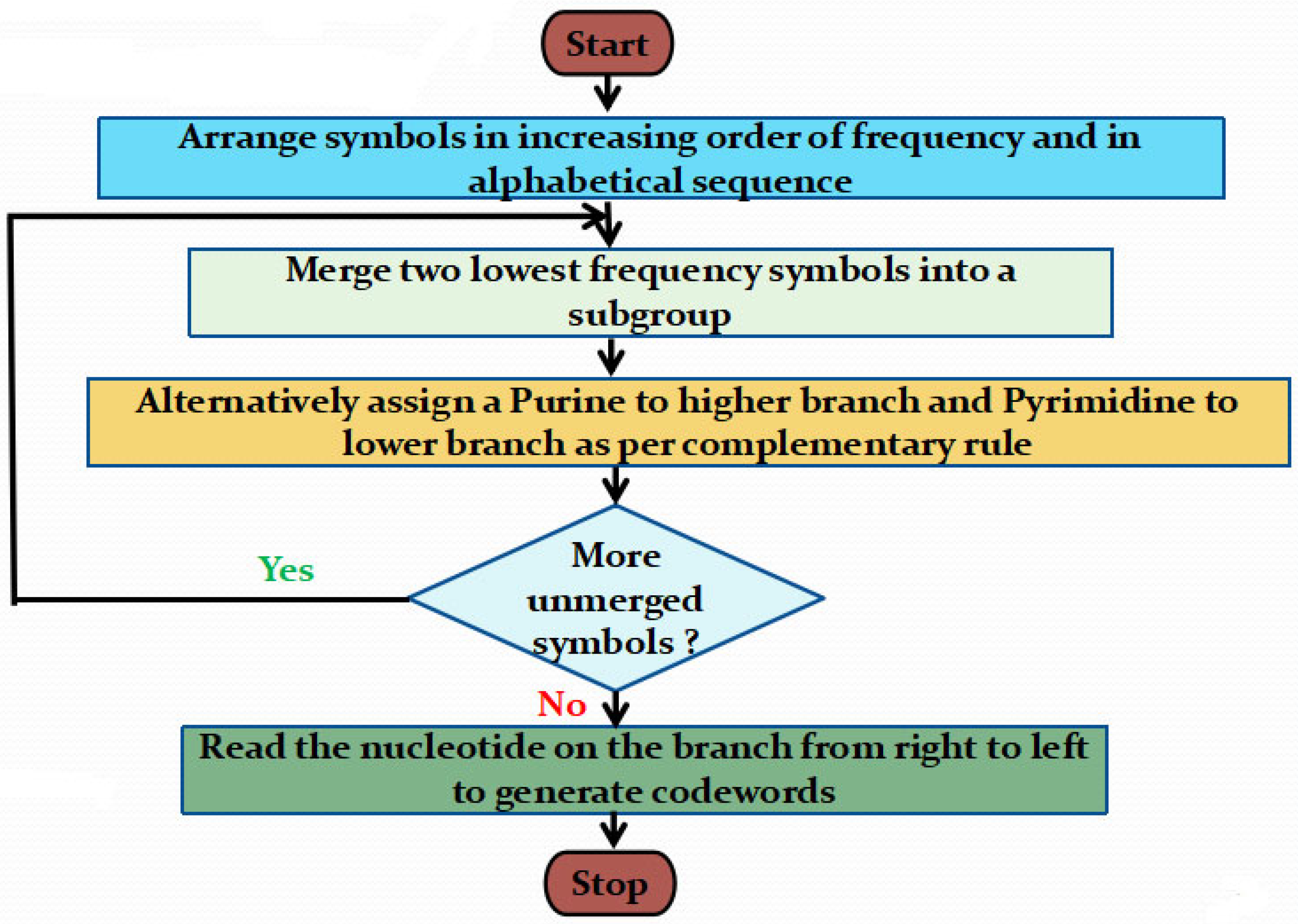
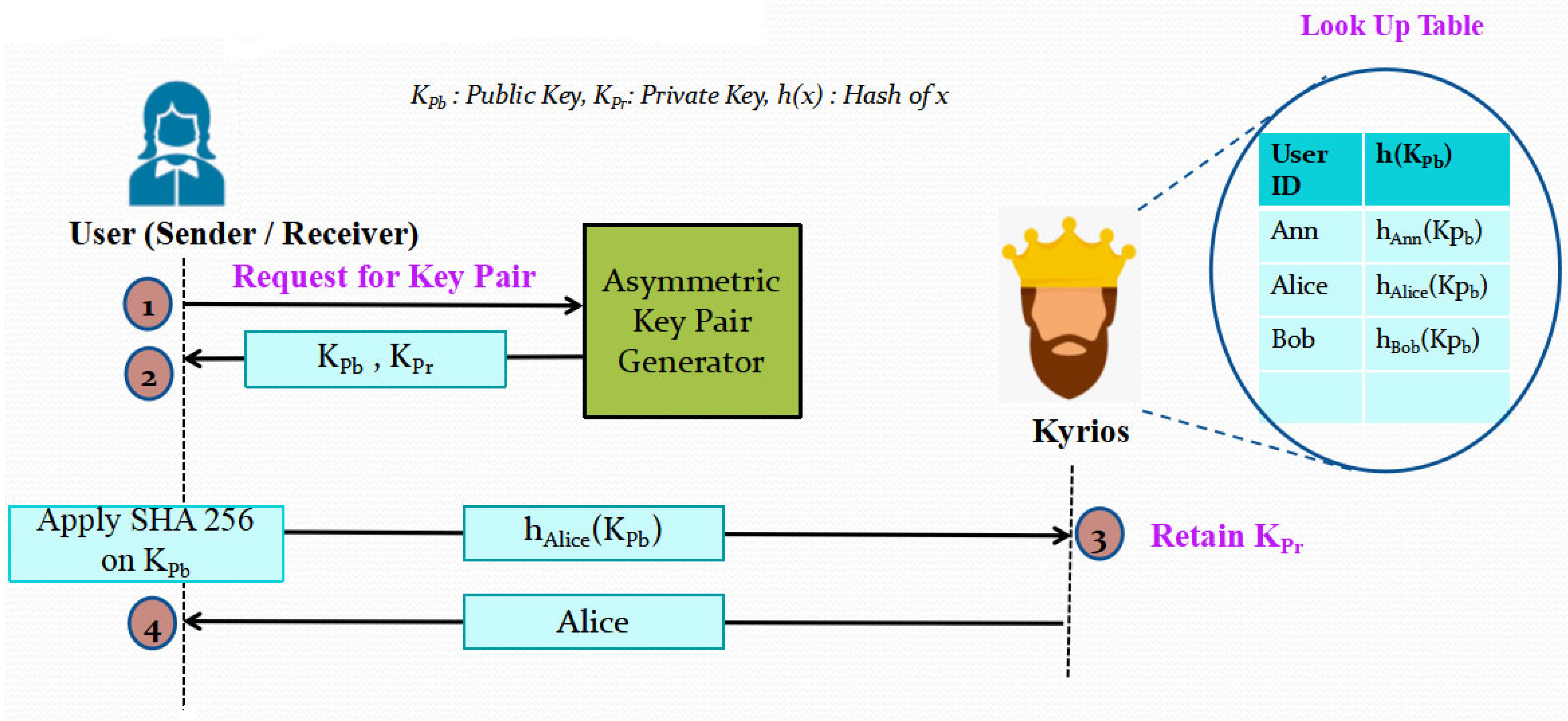

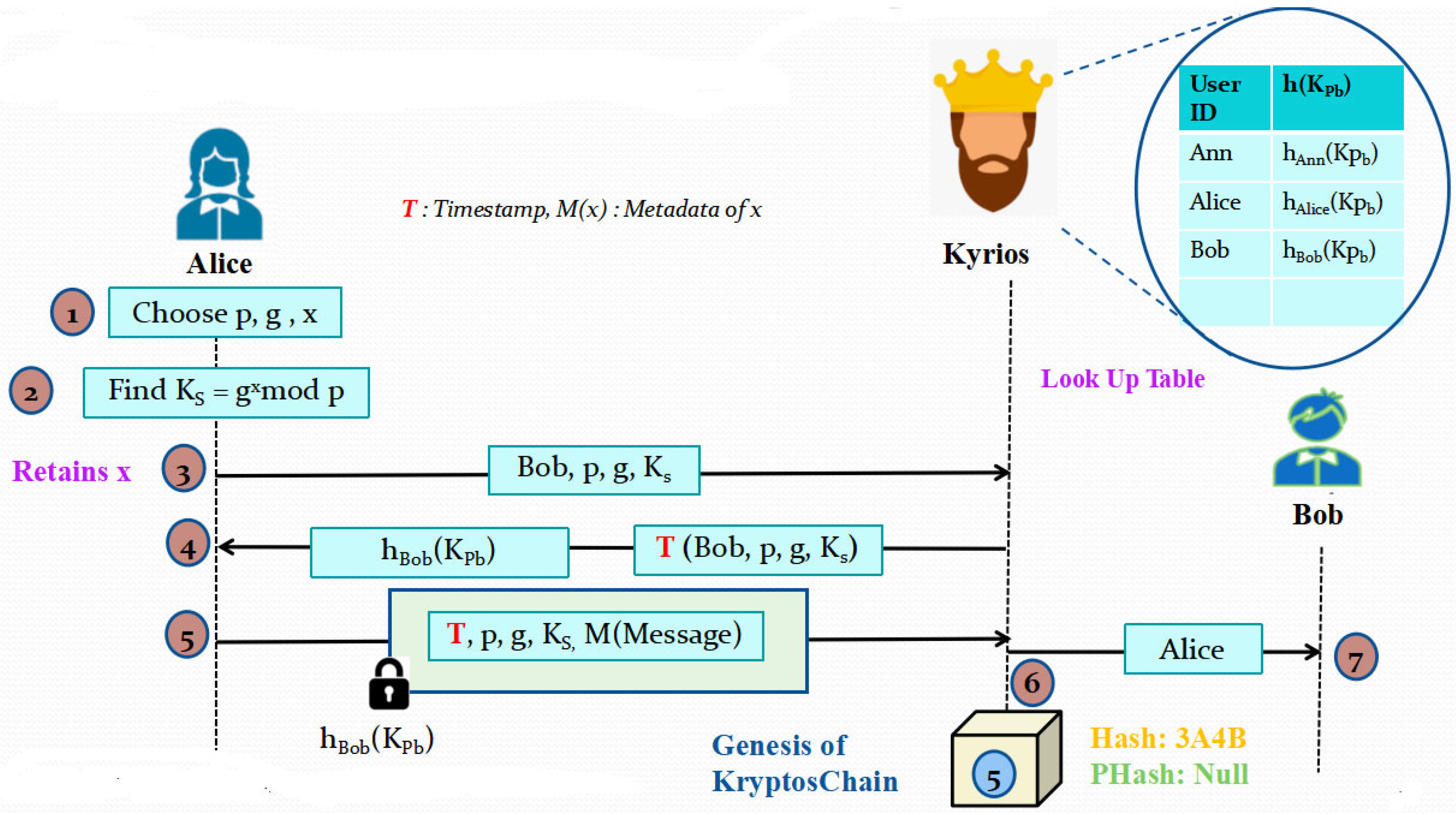
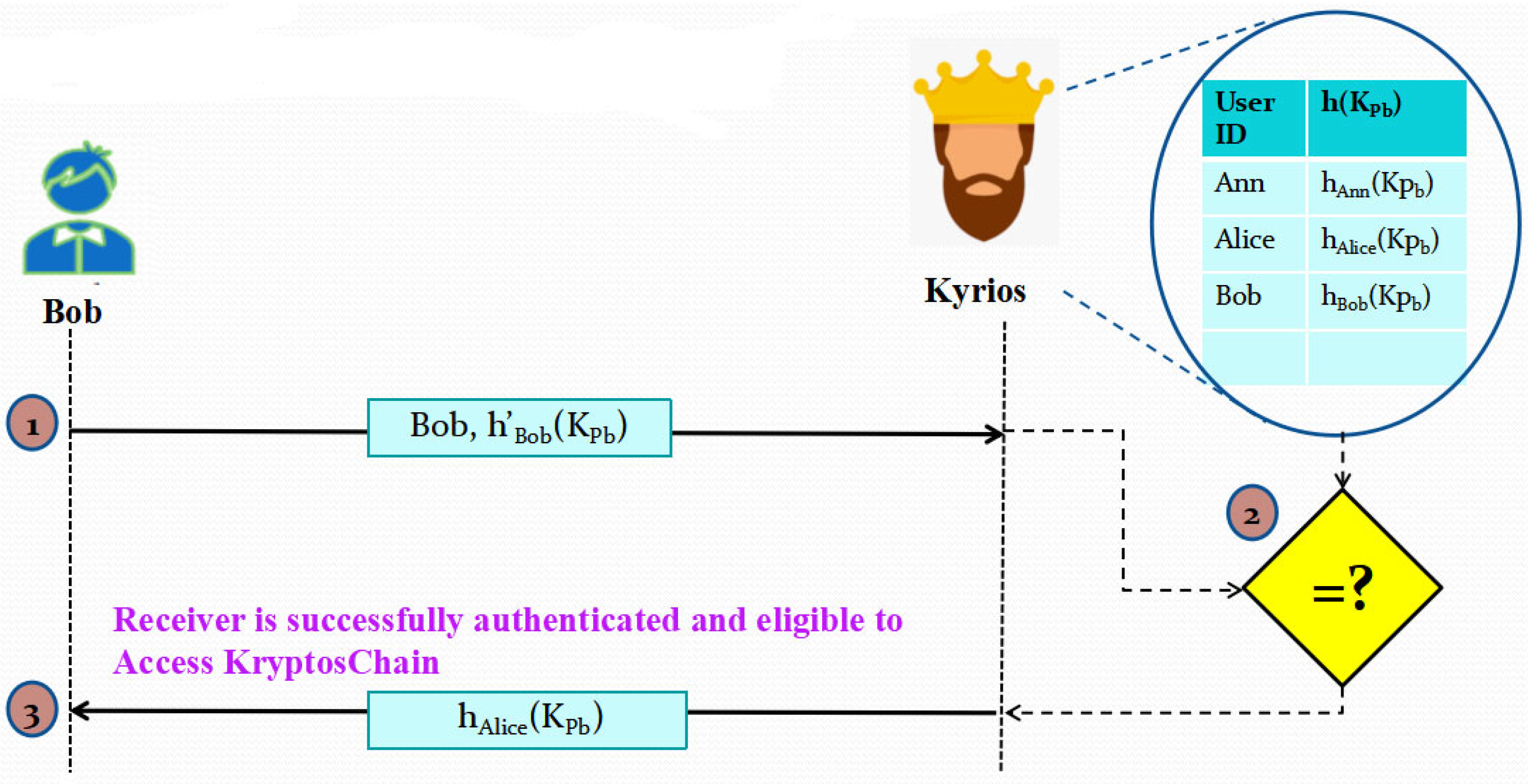


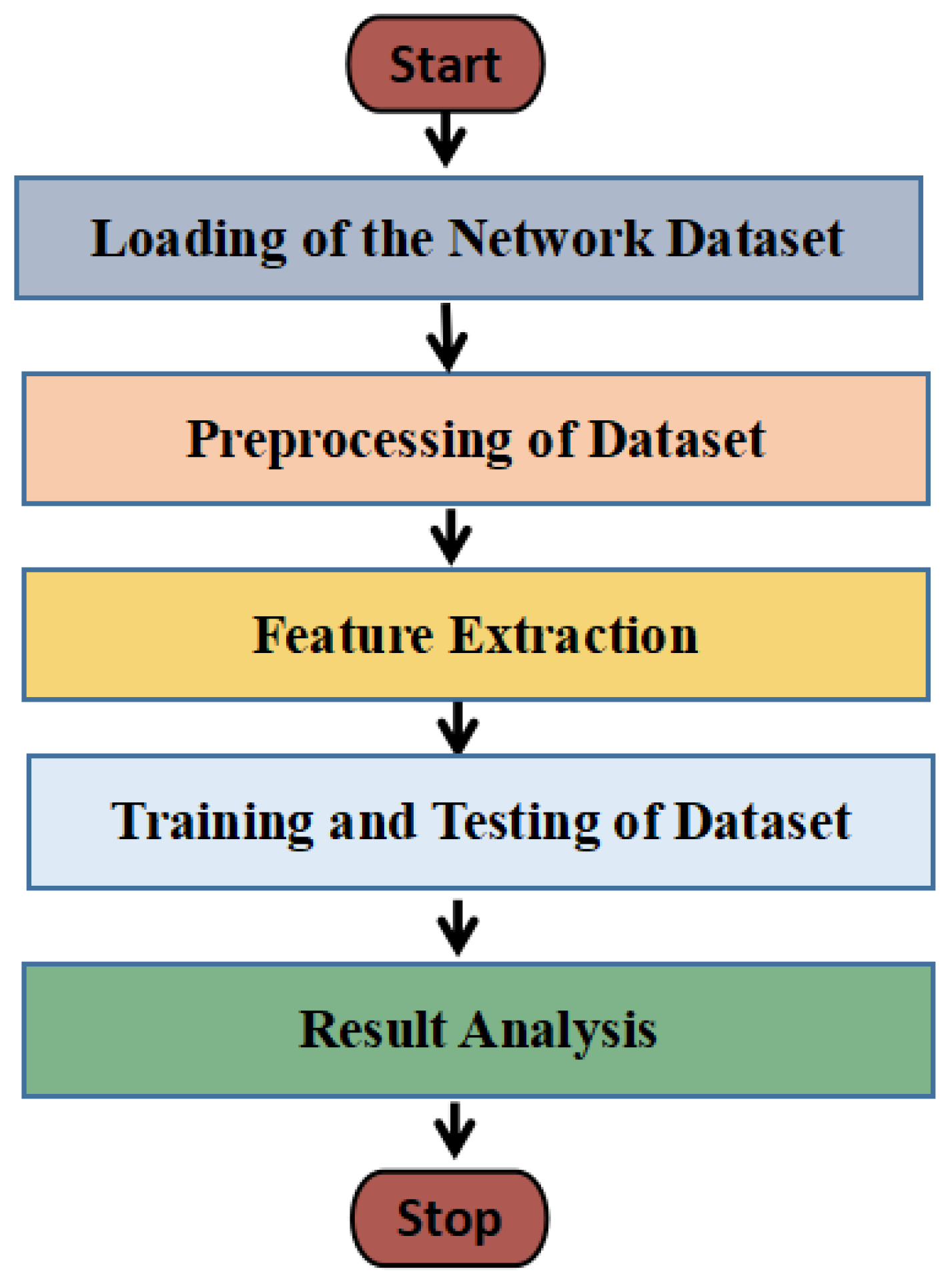


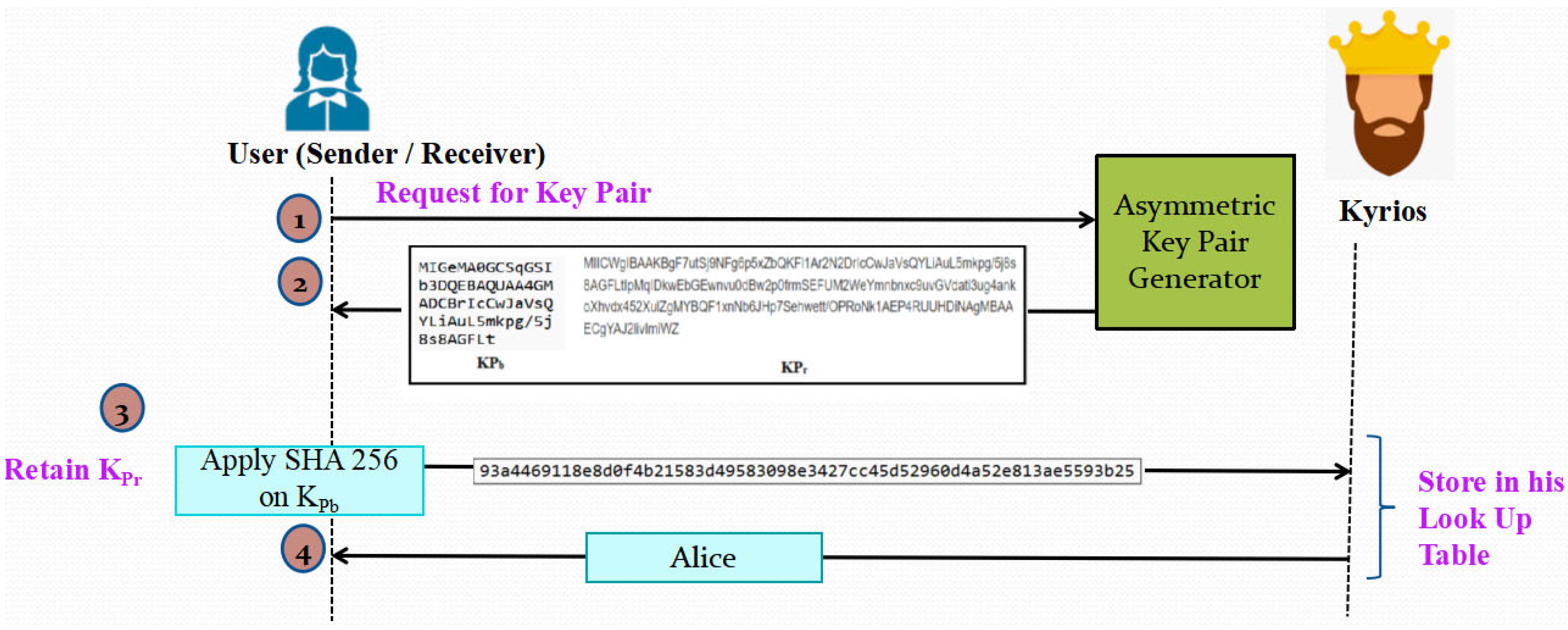


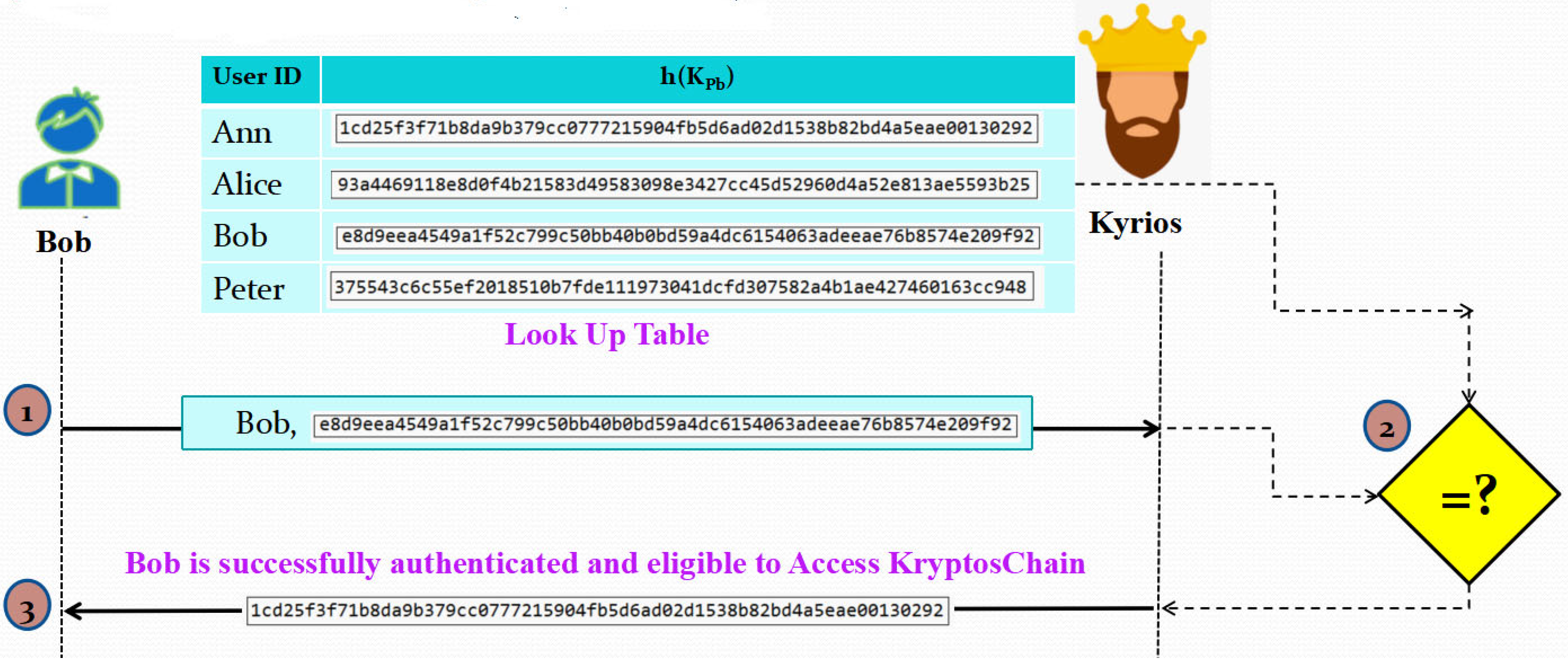
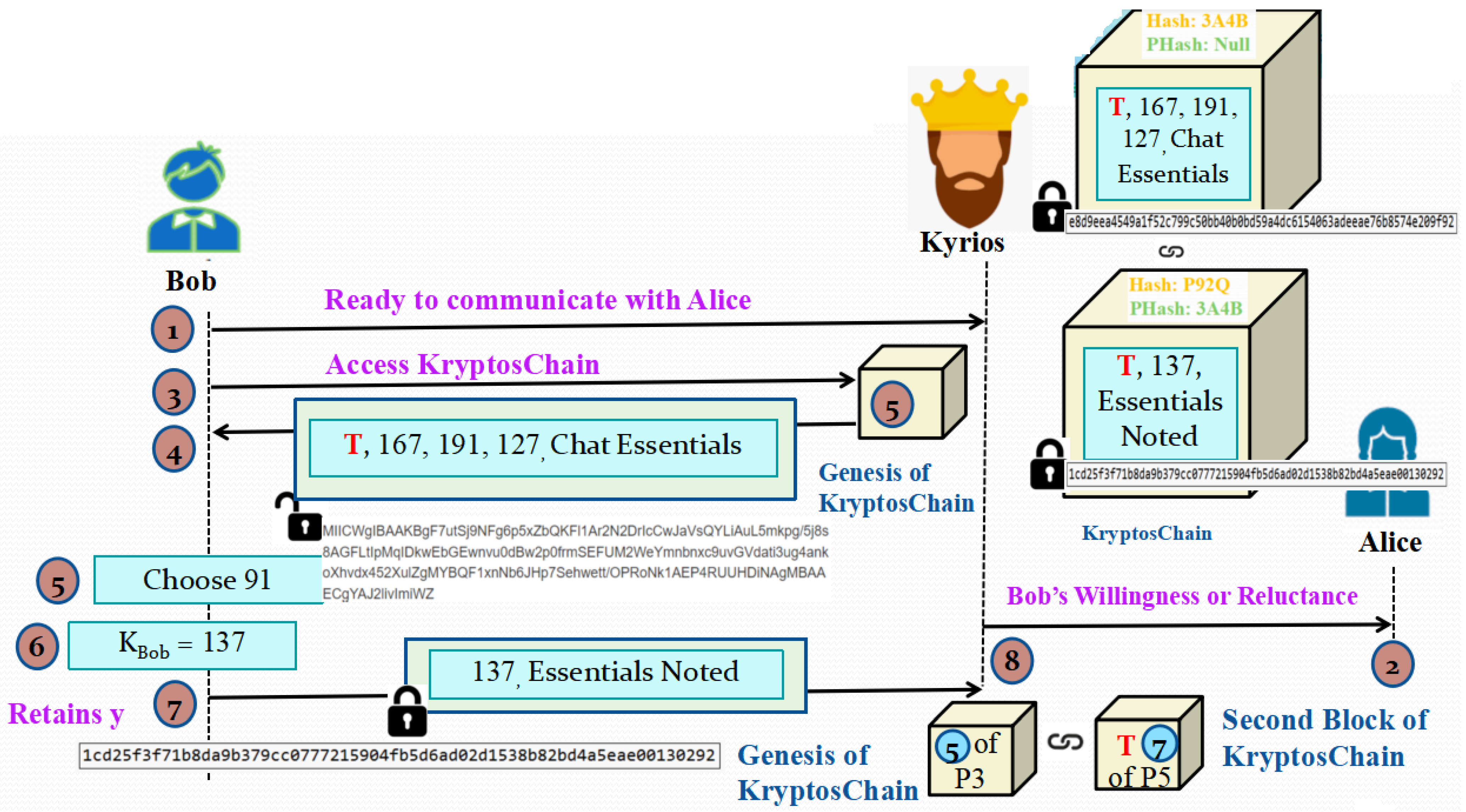


| A = CTG | B = ACC | C = GAC | D = GAT | E = GCG | F = AGT | G = ATG | H = CGT |
| I = AAG | J = AGC | K = AGG | L = TGC | M = TCA | "" = GCT | O = GAA | P = GTC |
| Q = ACA | R = CAC | S = AGT | T = TTA | U = ATA | V = CTT | W = CCA | X = CTA |
| Y = AAA | Z = CTT | 0 = ACT | 1 = AGC | 2 = TAG | 3 = GCA | 4 = GAC | 5 = AGA |
| 6 = TTC | 7 = ATT | 8 = AGC | 9 = GCT | , = CCC | . = GTC | ! = GCT | ? = CCT |
| Category | Involvement of Key | Encryption Time | Limitations |
|---|---|---|---|
| Substitution-based Schemes | No | Minimum |
|
| Biological Operations-based Schemes | Biological information is used as key-position of exon-intron, primer values etc. | Maximum |
|
| Mathematical–Biological Operations-based Schemes. | Keys are generated by stringent mathematical calculations | Moderate |
|
| Paper Title | Merits | Demerits |
|---|---|---|
| Provably secure covert communication on blockchain—Partala [32] |
|
|
| Light blockchain communication protocol for secure data transfer integrity—Guziur et al. [33] |
|
|
| Blockchain-based secure communication application proposal—Sarıtekin et al. [34] |
|
|
| Secure communications using blockchain technology—Menegay et al. [35] |
|
|
| A secure data sharing platform using the blockchain and interplanetary file system—Naz et al. [36] |
|
|
| An accelerated method for message propagation in blockchain networks—Bi et al. [37] |
|
|
| Secure Messaging Platform Based on Blockchain—Ellewala et al. [38] |
|
|
| Blockchain-enabled end-to-end encryption for instant messaging applications—Singh et al. [39] |
|
|
| Secure peer-to-peer communication based on Blockchain—Khacef and Pujolle [40] |
|
|
| Character | Frequency | Huffman Code |
|---|---|---|
| , | 1 | TGTGAGA |
| . | 1 | TGTGAGT |
| l | 1 | TGTGACTG |
| w | 1 | TGTGACTC |
| C | 1 | TGTGACA |
| g | 3 | TCCGGA |
| y | 3 | TCCGGT |
| u | 3 | TCCCTG |
| p | 4 | TCCCTC |
| f | 5 | TGTGT |
| c | 6 | TCCGC |
| m | 6 | TCCCA |
| d | 7 | ATGG |
| h | 9 | ATGC |
| r | 9 | ATCA |
| s | 9 | TCTA |
| a | 10 | TGTC |
| e | 11 | TCGA |
| i | 11 | TCGT |
| I | 13 | AAA |
| t | 15 | AAT |
| o | 19 | TGA |
| Parameter | Value | Further Specifications |
|---|---|---|
| Number of Features in the Dataset | 41 | Intrinsic Features 1–9 |
| Content Features 10–22 | ||
| Time-based Features 23–31 | ||
| Host-based Features 32–41 | ||
| Feature Type | 4 | Categorical (Features: 2, 3, 4, 42) |
| Binary (Features: 7, 12, 14, 20, 21, 22) | ||
| Discrete (Features: 8, 9, 15, 23–41, 43) | ||
| Continuous (Features: 1, 5, 6, 10, 11, 13, 16, 17, 18, 19) | ||
| Number Of Attack Classes | 22 | DoS Attack Classes 6 |
| Probe 4 | ||
| R2L 8 | ||
| U2R 4 |
| Parameter | Value |
|---|---|
| Number of Rows | 25,291 |
| Number of Columns | 42 |
| Number of Missing Values | 0 |
| Number of Duplicate Records | 0 |
| Load Distribution | Normal-13488 |
| Attack-11743 |
| Parameter | Value |
|---|---|
| Number of Rows | 11,850 |
| Number of Columns | 42 |
| Number of Missing Values | 0 |
| Number of Duplicate Records | 0 |
| Load Distribution | Normal-2152 |
| Attack-9698 |
| Protocol Type | Service | Flag | Protocol Type_Encoded | Service_Encoded | Flag_Encoded |
|---|---|---|---|---|---|
| icmp | http | SF | 1 | 10 | 9 |
| tcp | http | SF | 2 | 10 | 9 |
| tcp | ecr_i | SF | 2 | 5 | 9 |
| upd | private | SH | 3 | 15 | 10 |
| icmp | ecr_i | SF | 1 | 5 | 9 |
| udp | private | SH | 3 | 15 | 10 |
| tcp | http | SF | 2 | 10 | 9 |
| tcp | http | SF | 2 | 10 | 9 |
| tcp | http | SF | 2 | 10 | 9 |
| icmp | ecr_i | RSTR | 1 | 5 | 2 |
| src Bytes | dst Bytes | src Bytes_Normalized | dst Bytes_Normalized |
|---|---|---|---|
| 1032 | 0 | 0 | 0 |
| 230 | 1041 | 0 | 0 |
| 336 | 406 | 0 | 0 |
| 30 | 0 | 0 | 0 |
| 378 | 838 | 0 | 0 |
| 54,550 | 8341 | 1 | 1 |
| 278 | 6845 | 0 | 0 |
| 0 | 0 | 0 | 0 |
| 1032 | 0 | 0 | 0 |
| 333 | 710 | 0 | 0 |
| Spark-Chi-SVM Model | SVM with Reduced Features | ||
|---|---|---|---|
| No. of Features | Accuracy (%) | No. of Features | Accuracy (%) |
| 25 | 99.38 | 41 | 99.01 |
| 22 | 99.47 | 36 | 99.01 |
| 17 | 99.55 | 17 | 97.92 |
| 15 | 99.38 | 9 | 95.48 |
| 11 | 92.35 | 3 | 91.01 |
| Character | ASCII Code | Traditional DNA Code | Proposed DNA Huffman Code |
|---|---|---|---|
| , | 00101100 | CCC | TGTGAGA |
| . | 00101110 | GTC | TGTGAGT |
| l | 01101100 | TGC | TGTGACTG |
| w | 01110111 | CCA | TGTGACTC |
| C | 01000011 | GAC | TGTGACA |
| g | 01100111 | ATG | TCCGGA |
| y | 01111001 | AAA | TCCGGT |
| u | 01110101 | ATA | TCCCTG |
| p | 01110000 | GTC | TCCCTC |
| f | 01100110 | AGT | TGTGT |
| c | 01100011 | GAC | TCCGC |
| m | 01101101 | TCA | TCCCA |
| d | 01100100 | GAT | ATGG |
| h | 01101000 | CGT | ATGC |
| r | 01110010 | CAC | ATCA |
| s | 01110011 | AGT | TCTA |
| a | 01100001 | CTG | TGTC |
| e | 01100101 | GCG | TCGA |
| i | 01101001 | AAG | TCGT |
| n | 01101110 | GCT | AAA |
| t | 01110100 | TTA | AAT |
| o | 01101111 | GAA | TGA |
| Total number of bits | 176 Bits | 66 Bits | 113 bits |
| Parameter | Smith et al. [53] | Aeilenberg and Rotstein [54] | Meftah et al. [55] | Proposed Scheme |
|---|---|---|---|---|
| Frequency Distribution Value | Standard frequency of English alphabets | Standard frequency of English alphabets | Probability of appearance of a short Sequence in the initially chosen DNA string | Real-time occurrence of symbols in the considered plaintext |
| Type of Plaintext | Only English alphabets | All letters, numbers, characters | Input Image | All letters, numbers, characters |
| Resultant Huffman code for | ||||
| , | , = No Code | , = TAAT | No | , = TGTGAGA |
| . | . = No Code | . = TCTA | methodology | . = TGTGAGT |
| l | l = AAA | l = TTAG | described | l = TGTGACTG |
| w | w = AAT | w = TATG | for text | w = TGTGACTC |
| C | C = AAG | C = TTCG | symbols | C = TGTGACA |
| g | g = ACT | g = GAAT | g = TCCGGA | |
| y | y = ACC | y = TACG | y = TCCGGT | |
| u | u = AAC | u = TACT | u = TCCCTG | |
| p | p = CCA | p = GAAC | p = TCCCTC | |
| f | f = ACG | f = TAAG | f = TGTGT | |
| c | c = AAG | c = TTCG | c = TCCGC | |
| m | m = ACA | m = TAAC | m = TCCCA | |
| d | d = CT | d = TTAC | d = ATGG | |
| h | h = CA | h = TTTC | h = ATGC | |
| r | r = CG | r = TTTG | r = ATCA | |
| s | s = GT | s = TTCT | s = TCTA | |
| a | a = AT | a = GAC | a = TGTC | |
| e | e = T | e = GCT | e = TCGA | |
| i | i = GG | i = GCG | i = TCGT | |
| n | n = GC | n = TTAT | n = AAA | |
| t | t = AG | t = GTG | t = AAT | |
| o | o = GA | o = GAG | o = TGA | |
| As described by authors | ||||
| Re-usability of the codes? | Yes, as same Huffman tree is generated every time as frequency of characters remain the same. | Yes, as same Huffman tree is generated every time as frequency of characters remain the same. | No, as they are based on tedious biological processes. | No, as it considers real-time frequency of occurrence of the symbols involved. |
| Case sensitive? | No | No | Not applicable | Yes |
| Goal. | Status | Justification |
|---|---|---|
| Confidentiality | ☑ | Kyrios or a registered adversary cannot read the contents of the blocks as they are all encrypted. |
| Integrity | ☑ | Hash mismatch denotes any kind of tampering. |
| Availability | ☑ | All successfully registered users can access KryptosChain whenever needed. |
| Authentication | ☑ | Kyrios authenticates each user by referring to his look-up table and uses timestamps. |
| Non-Repudiation | ☑ | Basic immutability of KryptosChain and timestamps refute repudiations in the future. |
| Access Control | ☑ | Unwanted parties can be debarred from access by Kyrios and encryption resists man-in-the -middle attack. |
| Attack | Immunity | Justification |
|---|---|---|
| Ciphertext Only Attack | ☑ | The block containing the final Ciphertext, Huffman tree and other information is encrypted by the shared secret key established secretively between Alice and Bob through KryptosChain. Even Kyrios is not aware of this key. |
| Known Plaintext Attack | ☑ | The final DNA key is chosen from a pool of best DNA keys and changed for each encryption process. |
| Chosen Plaintext Attack | ☑ | The intruder needs to undergo the registration phase only; then, he gets access to KryptosChain and encryption machinery. |
| Chosen Ciphertext Attack | ☑ | The intruder needs to undergo the registration phase only; then, he gets access to KryptosChain and decryption machinery. |
| Replay Attack | ☑ | The intruder needs to undergo the registration phase only; then, he gets access to KryptosChain. |
| Side Channel Attack | ☑ | All the information is encrypted in the form of a chain of blocks. |
| Brute Force Attack | ☑ | All efforts are futile as everything is encrypted with suitable asymmetric keys, which are difficult to guess. |
| Parameter | Menegay et al. [34] | Naz et al. [35] | Ellewala et al. [37] | Singh et al. [38] | Khacef & Pujjole [39] | Proposed Scheme |
|---|---|---|---|---|---|---|
| Real Blockchain usage | Yes | Yes | Yes | Yes | Yes | No |
| Type of Blockchain | Public | Public with IPFS and smart contracts | Private with encryption | Public with digital certificates | Public with PKI | Not applicable |
| Crypto Currency | Yes | Yes | Yes | Yes | Yes | No |
| Comments | Email server added in an existing Blockchain | Digital assests are shared and delivered | Restricted to a single enterprise | Each user uploads his public key certificate into the Blockchain | Instead of CA Blockchain enables distribution of keys | A Blockchain-inspired Diffie Hellman protocol is used |
| Limitations | Scalability issues as number of users increases | Economically cumbersome | Private blockchains are expensive | Highly dependent on MNO to provide certificates | Scalability issues as number of users increase | 6 phases need to be passed |
| Classifier | Accuracy (%) | Precision | Recall | F-Score | Time to Train (msec) | Sensitivity (%) |
|---|---|---|---|---|---|---|
| NB | 78.35 | 0.812 | 0.785 | 0.798 | 2457 | 75.45 |
| Logistics | 82.47 | 0.856 | 0.815 | 0.836 | 2490 | 83.14 |
| MLP | 80.35 | 0.808 | 0.785 | 796 | 2503 | 79.89 |
| SMO | 85.56 | 0.832 | 0.798 | 0.814 | 2734 | 84.67 |
| IBK | 91.35 | 0.837 | 0.807 | 0.821 | 2556 | 91.28 |
| J48 | 95.84 | 0.868 | 0.838 | 0.852 | 2769 | 96.78 |
Disclaimer/Publisher’s Note: The statements, opinions and data contained in all publications are solely those of the individual author(s) and contributor(s) and not of MDPI and/or the editor(s). MDPI and/or the editor(s) disclaim responsibility for any injury to people or property resulting from any ideas, methods, instructions or products referred to in the content. |
© 2023 by the authors. Licensee MDPI, Basel, Switzerland. This article is an open access article distributed under the terms and conditions of the Creative Commons Attribution (CC BY) license (https://creativecommons.org/licenses/by/4.0/).
Share and Cite
Mukherjee, P.; Pradhan, C.; Tripathy, H.K.; Gaber, T. KryptosChain—A Blockchain-Inspired, AI-Combined, DNA-Encrypted Secure Information Exchange Scheme. Electronics 2023, 12, 493. https://doi.org/10.3390/electronics12030493
Mukherjee P, Pradhan C, Tripathy HK, Gaber T. KryptosChain—A Blockchain-Inspired, AI-Combined, DNA-Encrypted Secure Information Exchange Scheme. Electronics. 2023; 12(3):493. https://doi.org/10.3390/electronics12030493
Chicago/Turabian StyleMukherjee, Pratyusa, Chittaranjan Pradhan, Hrudaya Kumar Tripathy, and Tarek Gaber. 2023. "KryptosChain—A Blockchain-Inspired, AI-Combined, DNA-Encrypted Secure Information Exchange Scheme" Electronics 12, no. 3: 493. https://doi.org/10.3390/electronics12030493
APA StyleMukherjee, P., Pradhan, C., Tripathy, H. K., & Gaber, T. (2023). KryptosChain—A Blockchain-Inspired, AI-Combined, DNA-Encrypted Secure Information Exchange Scheme. Electronics, 12(3), 493. https://doi.org/10.3390/electronics12030493








